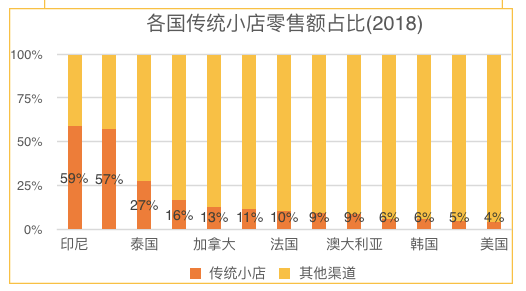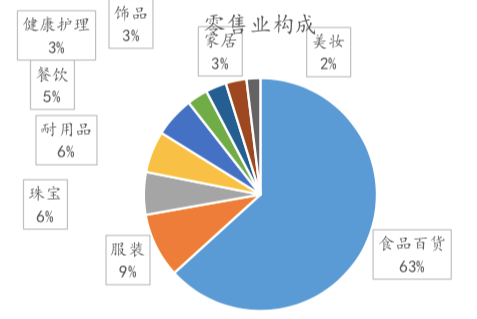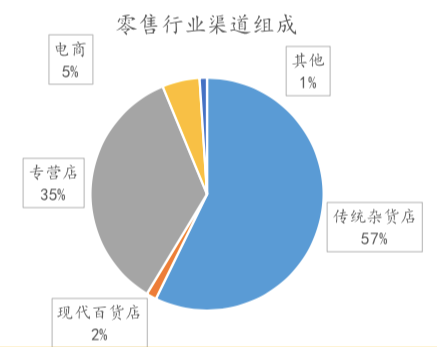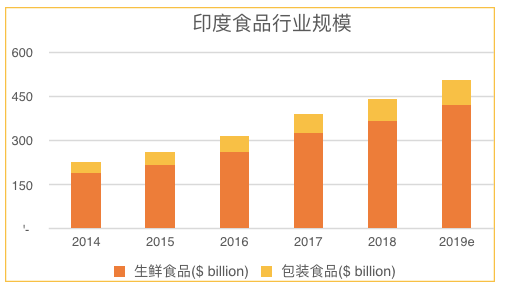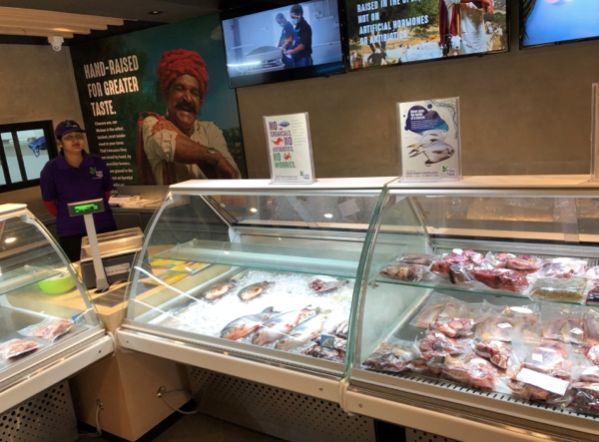What areas of India have opportunities? Why is there a chance?
Editor’s note: This article is from WeChat public account “墨腾创投” (ID: MomentumWorks)< /a>, the author Yu Fei, Liu Wei.
I went to India for the first time last summer, and it has been almost a year since now. In this year, I have thought a lot from the perspective of going to the specific field: What areas have opportunities? Why is there a chance?
India’s fresh groceries market is an area that I have studied in depth. I will share what I have seen and what I think about it
Why are you concerned about the Indian grocery market?
Some people have a deep-rooted misunderstanding about India. On the one hand, this misunderstanding comes from understanding that there are fewer channels, the information is not smooth enough, and on the other hand it comes from the lack of dynamic and developmental perspectives. Especially in terms of diet and lifestyle, there are many misunderstandings and rumors about Indians.
This article will take the research of the author’s Indian fresh groceries as an example to let everyone know about the daily life of Indians.
Macro analysis of fresh and groceries in India
1. Perceptual knowledge of India’s fresh retail offline industry
India offline fresh retail is mainly divided into four different main formats: mobile retail vendors, Kirana (couples and wives), vegetable market, and large and small supermarkets. Here are some sample images of these formats I visited, giving you some perceptual insights:
Mobile retail vendors: Everywhere in India, and a wide variety of products

Kirana: Most of them belong to franchise stores, generally 20~50 flat. Among them, meat fish is sold in the hot weather on the street like the picture below, and the price is not cheap.

Dish Market (Bangalore Central Market): Large area, full range, vegetables, fruits, meat, and aquatic products are separate areas, but the number of centralized food fields is small. This dish is not only toC. The owner of the small Kirana will also be stocked here.

Small supermarket (reliance fresh, mega mall, big bazzar, food hall). Indian supermarkets are differently positioned, but most supermarkets do not have meat sales. Only a small number of supermarkets with a few thousand squares (visiting a mega mall) have separate meat sales areas and are generally a separate room with Other areas are separated.
The price of a supermarket will be cheaper than that of Kirana. For larger supermarkets, about one-third of the goods will be discounted on the basis of MRP (highest retail price, note later).

2. CityField size
The Indian retail market was 631 billion U.S. dollars in 2018, with an annual growth rate of 9%, and 63% of its retail products are food and department stores.
In the food sector, about 80% are fresh food ($367 billion), including $175.1 billion in fruit, $982 billion in vegetables, $52.8 billion in fish, and $35 billion in meat. In the entire retail market, Kirana is the leading retail format (2017 statistics, India has 12.7 million Kirana, annual growth rate of 0.5%), especially in the fresh retail sector, which is dominated by China’s previous vegetable market. And the fresh retail business that gradually shifted to the big supermarket has produced a big difference.

3. Trends
From the perspective of policy, India has gradually opened up foreign investment controls in the retail sector in recent years. The traditional format represented by Kirana has shifted to chain and e-commerce. However, unlike China’s first chain integration and e-commerce, India’s retail industry is shifting to the e-commerce platform and franchise stores.
Like China’s view of the development of the Internet in India, we cannot simply benchmark the same period of economic conditions in India and China. We must also consider India’s more developed 4G coverage and the reference of the Chinese Internet model. Today Indian businessMost of the exhibitions are mix.
In terms of results, traditional Indian grocery stores (57% market share) release an average of 1.1%-1.3% market share per year, and the average e-commerce market share (5.2% market share) increases by 0.6%-0.9% per year. The average annual penetration rate of franchised stores (market share 35%) increased by 0.4%-0.6%; however, the share of modern retail channels (market share 1.4%) remained basically unchanged.


Different retail sales in India

Chinese and Indian different trend transfer trend column comparison chart and table
4. Indian eating habits
Indians’ eating habits can be roughly described by late dinner, less variety, and cultural influence. Usually at 9 or 10 o’clock in the morning, breakfast is only started; lunch is usually after 1 pm, between lunch and dinner, there will be an afternoon tea after 4 o’clock. Dinner is usually after 8pm.
In terms of content, most of the printed dishes are soups mixed with various seasonings, among which the real meat and vegetables are rare, and most of the rest are yellow seasoning soup, followed by Indian rice or bread. (Naan) squatting to eat, so although India still retains the lifestyle of the big family, the number of meals often does not need a lot.
And because of culture, there are more Indians who believe in Islam, and because of Indians.I don’t like the fat in meat, and the pork is very small. Therefore, fish, chicken and lamb are the main types of Indian meat diet.
It is precisely because of the low variety of Indian foods that the number of vegetables sold by the mainstream Kirana in the first market is more than ten or twenty, which can meet the daily needs of most families, and the fruits and vegetables are roots and stems. Mainly class, less green leafy vegetables, and low loss rate;
The other dimension is also due to the lack of diversity, resulting in fewer take-away products in India, and the growth rate of take-out orders is far below market expectations (the order level of the two major platforms is at a single level of 1 million).
In addition, India has about 27% of vegetarians, and the higher the income, the higher the proportion of vegetarianism. In addition, milk is a very important ingredient in India. Milk, milk tea, cooking, etc. all use milk.
As you can see from the picture below, India’s per capita milk consumption is equivalent to the level of developed countries, and it is increasing year by year, far more than the per capita milk consumption in China, and it is also the demand for milk consumption. A business model unique to India’s fresh e-commerce will be mentioned later.


Tips1:
Indian commodity circulation knowledge: MRP system (Maximum Retail Price, highest retail price)
-
The highest retail price rule: Indian law requires that the item must be marked with the highest retail price, and the final retail price cannot exceed this price.p>
-
The original intention of the government:Protect consumers
-
Who decides: The MRP for most products is determined by the manufacturer at the factory, and some key commodities are determined by the state (medical related products, commodities, key energy, etc.).
-
The general daily necessities market price will be slightly lower than MRP, but the products related to gift attributes (small appliances, etc.) will be sold at a much lower price than MRP, which is mainly for people to give gifts better. Psychological experience.
-
Small and medium-sized retailers, remote city retailers, and rural retailers: There is no advantage at the cost end, and the income side cannot collect a premium, which hinders their enthusiasm for development. Even if Kirana offers great convenience, there is no way to charge a premium for this service.
-
The market dispute is relatively large and has been partially loosened. The Indian Supreme Court allowed the price of bottled drinking water in restaurants to exceed MRP.
-
There is no MRP in bulk and fresh in bags.
So the price difference between the various channels of Coke in China is very different. Most of the Cokes purchased in Kirana, India will be sold according to MRP. The larger the channel, the different Discount.
Although the MRP system has now received some doubts, but in the case of packaged standards, because of the MRP system, there will be no special channels for slaughtering, and we will be able to clear from the terminal. The analysis of the profit distribution ratio at each level in the Indian supply chain (compared to how much discount MRP purchases).

Tips2:
Comparison of the status and valuation of listed companies in China and India (open market data collection, the last four are Indian companies)
 < /p>
< /p>
A brief analysis of several patterns that already exist on the line
1. Grocery, fresh platform e-commerce
This kind of project is represented by two unicorn projects in India (Bigbasket, Grofers). The model is similar to the domestic Tmall supermarket, but the difference is that the project is trying to do its own brand in the occupation market stage. Features are as follows:
-
The unit price is high, the average customer price is 15~30 dollars;
-
sku More: Thousands to tens of thousands of sku, stock up in advance;
-
T+1 mode-based, primary one-to-two-week centralized procurement needs, is currently doing T+0 attempts;
-
Offline competition directly targets Big Bazza r, D-mart supermarket.
2. Fresh-day distributors based on milk distribution (similar to community buying and subscription e-commerce in China)
Daily Fresh E-commerce is a format with local Indian characteristics:
Background: Indians are a nation highly dependent on milk. They drink fresh milk every day, and because of the diet, fresh milk is an important raw material such as Indian tea, coffee, and catering.
The vast majority of the Indian market is cold milk with a shelf life of only 24 hours (in fact, it is a pasteurized milk with a shelf life of 7 to 14 days, but the milk company sells according to the shelf life of fresh milk). There are three main ways to buy it:
The first: is a fresh milk store directly operated by the milk brand, as shown in the picture of the Delhi Daily NCR Mother Daily, which is generally 10~20 The left and right sides (which will extend some areas) are mainly composed of two refrigerators. The inside sku mainly includes different milk, some dairy products, and a small amount of breakfast items. The business hours are generally two hours in the morning and evening.

Second: Traditional community milk distribution system maintained by milkman.
There are two points that differ from the domestic ones more than a decade ago. One of the milkman is an independent individual and not a milk brand employee, so the milkman’s sku is not limited to a specific brand, but rather richer than the offline; /p>
Second, the purchase mode is slightly different from the domestic monthly order. Milkman will sell the family milk voucher in advance, and then if the family needs fresh milk, put a special milk voucher in the door pocket, milkman comes in the early morning of the next day. Will take the milk coupon and put the corresponding milk;
milkman goes to the milk terminal every night to get milk, usually about tens of liters, 5~7 in the morning, if it is slightly more or slightly less, it will be replenished through the surrounding fresh milk stores; the milk station will give the dealer The discount is generally between 8 and 12%. The unit price is a one that can earn 3 to 4 rupees a day.
The third type: all kinds of retail formats under the line, as long as there is almost refrigerated place, there will be fresh milk sales, but the number of sku is small and the inventory depth is low.
China has experienced similar stages of fresh milk distribution, but it is different from what I saw in India: First, for the Chinese, milk is not a must, but a supplement; The fresh milk distribution system is dominated by brand parties, and soon entered the era of pasteurized milk and normal temperature milk; the third is that there is no Internet e-commerce in that day. Based on the above reasons, India has formed its own high-frequency, low-cost unit price daily fresh-keeping e-commerce project.
Features:
-
Day with high frequency (monthly repurchase 15~22 times)
-
Pre-pay
-
The unit price is low (50~200 rupees);
-
Sku Less: Based on milk, we can expand other products by high-frequency milk products, and expand up to several hundred SKUs;
-
Once a day, delivery in the early morning.
3. Channel and supply chain integration (including vertical category e-commerce, product channel brand, B2B supply chain, etc.)
Because the above mentioned that offline retailing in India is a fragmented retail business dominated by Kirana, on the one hand, goods flow in the middleThere are many supply chain levels, and the terminal price is high. On the other hand, the fragmentary Kirana has a small number of skus because of the limited sales volume of single stores. In the field of fresh meat, especially meat and seafood, the quality of the products is not satisfactory, which gives The opportunity for the terminal to integrate the supply chain.
India, there are a series of projects that shorten the intermediate supply chain hierarchy. Whether it is to integrate vertical products into product or channel brands, or to empower Kirana, expand small B product categories or improve product transfer efficiency. many.
In addition, India’s supply chain upgrade is subject to infrastructure construction, such as road traffic, cold chain logistics capabilities need to develop for a long time, but the specific population (head middle) quality for specific cities (first-tier cities) The upgrade is just a matter of need.
In India, franchise chains have been seen to offer better quality products.
4. What is the same as in China, what is the difference?
Like domestic online fresh groceries, the positioning of users is based on the Indian groceries online products and core battlefields in Tier1 cities and a small number of Tier2 cities. The main coverage is the head of the Indian population. On the one hand, the head group has more consumption of fresh and groceries (20% of the heads have a market share of nearly 50%), on the other hand, the customer and Internet penetration rate. , payment and logistics infrastructure conditions in core cities are better, and order density is easier to make, and regional order density is one of the core indicators of most online fresh groceries.
Different from the domestic environment, India’s labor costs are relatively cheap. According to the results of my research and interviews, the courier of India’s self-provided motorcycles is expected to have an hourly wage of $1 to $1.2, and the average deliveryman’s hourly wage is At 0.8 USD, a factory sorting staff can only spend 1,000 yuan per month on board and lodging. This is at least double the current level of China. This has led to the fact that in the case of the same order density, Indian fresh groceries can have lower fulfillment costs and thus lower customer unit prices.
So under specific demand and economic models, it is possible for India to make a platform-type e-commerce with a price of 1 to 2 US dollars and a positive contribution Margin. It is still difficult to reach this level in China.
Why are you optimistic, what opportunities?
1. Why is there an opportunity in the Indian market?
There are two important development factors that we have easily overlooked before, coherent and stable political system, open government and continuous introduction of talents. There are also some common reasons: demographic dividends, economic growth, Internet dividends, consumption improvement Timing, and more.
2. Why is there a chance in the Indian fresh and grocery market?
-
Fast growth: Population growth is fast, and eating is still the most important consumption segment for local residents;
-
High efficiency replaces inefficiency: A large number of small Kiranas still occupy an absolute share of the market, and this part of the annual market share loss must be replaced by emerging models;
-
Consumer consumption and quality upgrades: As with China 20 years ago, how to sell safe meat and rest assured that fish is still a relatively difficult thing in today’s society in India. In addition, India’s head 50M ~ 100M people, consumption power is very strong.
3. Advantages and Disadvantages of Indian Fresh and Grocery Market Development
Benefits:
-
The demographic dividend is obvious, and eating is the biggest expenditure for Indian household consumption;
-
India’s big family model, the demand for home cooking is relatively strong, and fresh e-commerce is more demanding than take-out;
-
India, the climate is warm and the precipitation is high throughout the year. Most of the regions can be cooked twice a year or three times. From the source, the quality of the farmland in India is the first in Asia, reaching 1.6. 100 million hectares;
-
Unorganized Kirana is the main local supply format, but the trend of unorganized formats shifting to organized (expressing more than 1% of the market each year);
-
The local quality supply is scarce, lacking the franchise of fresh chain business (such as Baiguoyuan, Xianfeng Fruit, etc.), and there is no good local fresh brand;
-
The Internet coverage is wide, penetration rate is increasing, and mobile payment is higher than other countries in China;
-
The cost of labor is cheap and the last mile is cheap.
